brakes PONTIAC BONNEVILLE 1996 User Guide
[x] Cancel search | Manufacturer: PONTIAC, Model Year: 1996, Model line: BONNEVILLE, Model: PONTIAC BONNEVILLE 1996Pages: 387, PDF Size: 18.71 MB
Page 175 of 387
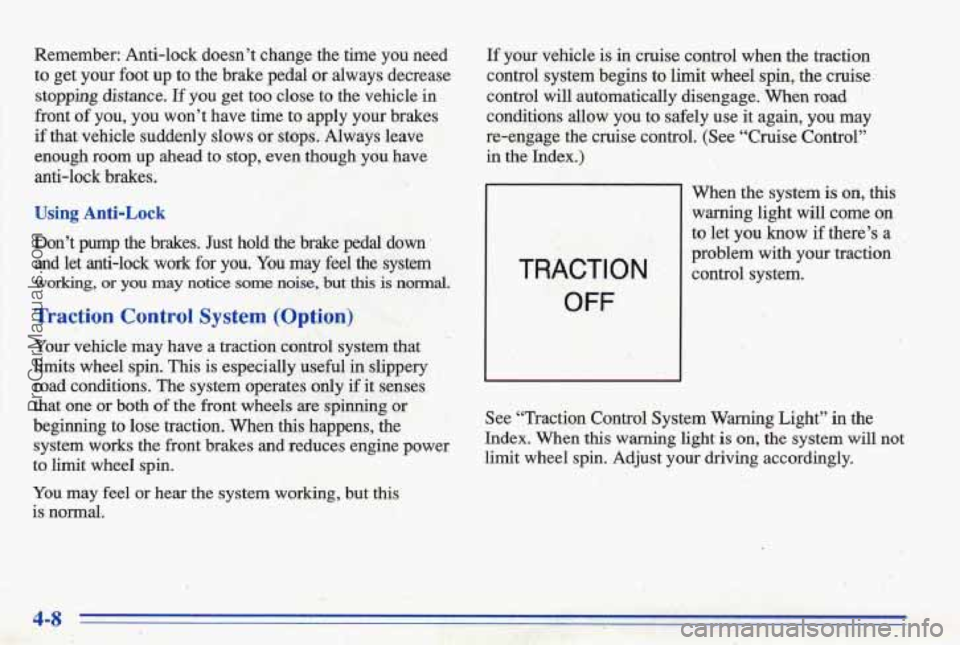
Remember: Anti-lock doesn’t cfiange the time you need
to get
your foot up to the brake pedal or always decrease
stopping distance. If you get too close to the vehicle in
front of you, you won’t have time to apply your brakes
if that vehicle suddenly slows
.or stops. Always leave
enough room up ahead to
stop, even though you have
anti-lock brakes.
Using Anti-Lock
Don’t pump the brakes. Just hold the brake pedal down I
and let anti-lock work for you. You may feel the system
workg, or you may notice some noise, but this is normd.
Traction Control System (Option)
Your vehicle may have a traction con&ol system that
limits wheel spin. This is especially useful in slippery
road conditions. The system operates
only if it senses
that one
or both of the front wheels are spinning or
beginning to lose traction. When this happens, the
system works the front brakes and reduces engine power
to limit wheel
spin.
You may feel or hear the system working, but this
is normal,.
If your-vehicle is in cruise control when the traction
control system. begins
to limit wheel spin, the cruise.
control
will automatically disengage. When road ’
conditions allow you to safely use it again, you may
reengage the cruise control. (See “Cruise
Control”
in the Index.)
TRACTION
OFF
Men the system is on, this
warning light will come on
to kt
you know if there’s- a
problem with. your traction
control system.
See “Traction Control System
Warning Light’’ in the
Index. When this warning light is on, the system will not
limit wheel
spin. Adjust your driving .., ’. . ~ i 1 accordingly. --- ,.! “ A
. e. -. .l’ i-!
.. . ..
ProCarManuals.com
Page 178 of 387
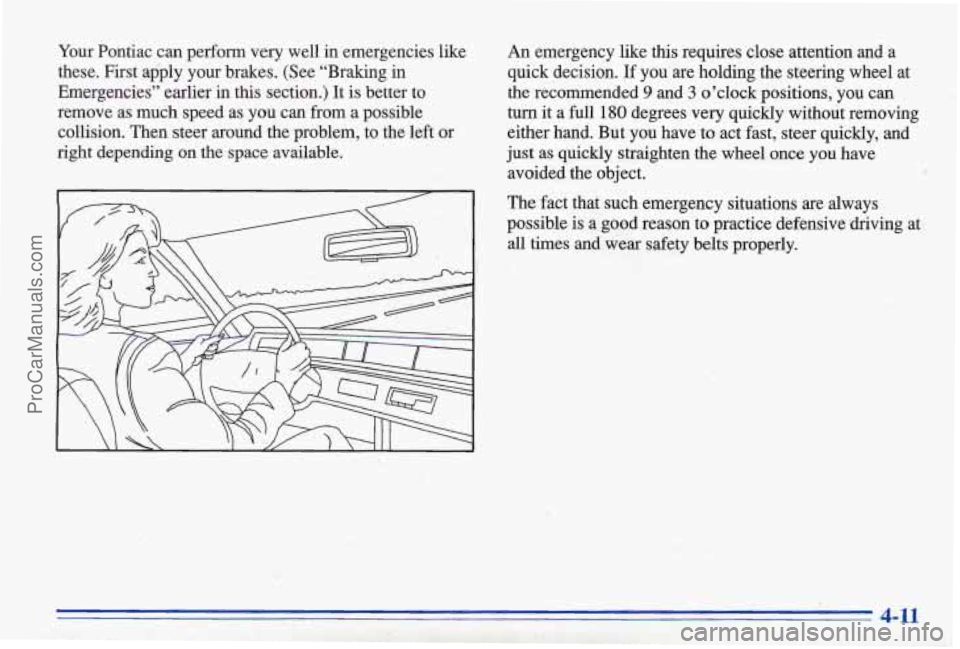
Your Pontiac can perfom very well in emergencies like An emergency like this requires close attention and a
these. First apply your brakes. (See ‘‘Braking in quick decision. If you are holding the steering wheel at
Emergencies” earlier in this section.) It
is better to
the recommended 9 and 3 o’clock positions, you can
remove as much speed as you can from
a possible turn it a full 180 degrees very quickly without removing
collision. Then steer around the problem, to the left or
either hand. But you have to act fast, steer quickly, and
right depending on the space available. just as quickly straighten the wheel once you have
avoided the object.
,
The fact that such emergency situations are always
possible is a good reason to practice defensive ‘driving at
all times and.wear safety belts properly.
4-11 ... .
ProCarManuals.com
Page 181 of 387
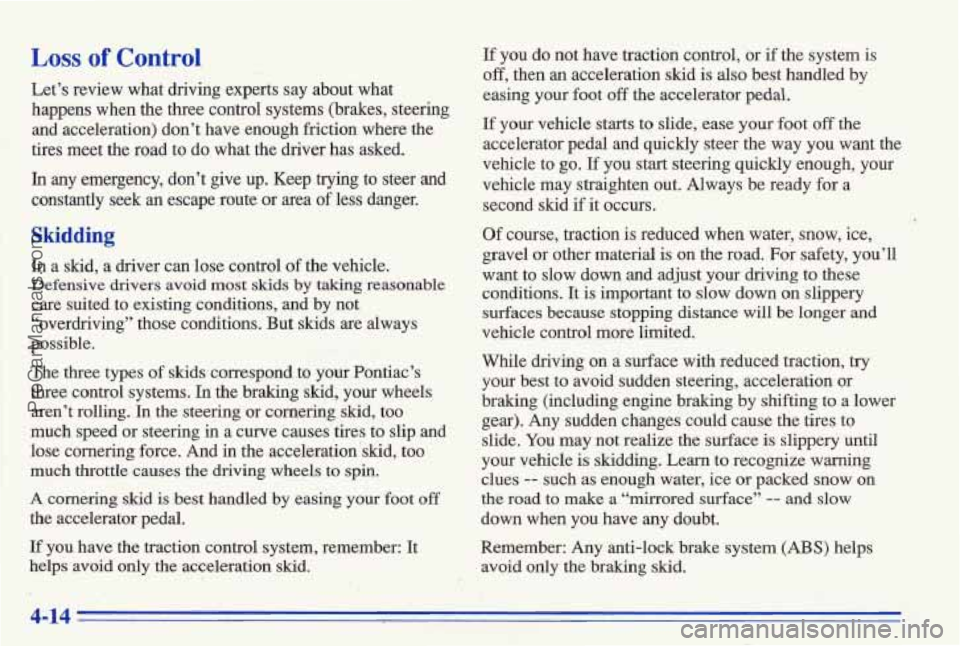
Loss of Control
Let’s review what driving experts say about what
happens when the three control systems (brakes, steering and acceleration) don’t have enough friction where the
tires
meet the road to do what the driver has asked.
In any emergency, don’t give up. Keep trying to steer and
constantly seek
an escape route or area of less danger.
Skidding
In a skid, a driver can lose control of the vehicle.
Defensive drivers avoid most skids by taking reasonable
care suited to existing conditions, and by not
“overdriving” those conditions. But skids
are always
possible.
The three types of skids correspond to your Pontiac’s
three control systems. In the braking skid, your wh’eels
aren’t rolling.
In the steering or cornering skid, too
much speed or steering in a curve causes tires to slip and lose cornering force. And
in the acceleration ‘skid, too
much throttIe causes the driving wheels
to spin.
A cornering skid is best handled by easing your foot off
the accelerator pedal.
If you have the traction control system, remember: It
helps avoid
only the acceleration skid.
If you do not have traction control, or if the system is
off, then an acceleration skid is also best handled by
easing your foot off the accelerator pedal.
If your vehicle starts to slide, ease your foot off the
accelerator pedal and quickly steer the way you want the
vehicle to
go. If you start steering quickly enough, your
vehicle may straighten out. Always be ready for a second skid if it occurs.
Of course, traction
i,s reduced when water, snow, ice,
gravel or other material
is on the road. For safety, you’ll
want to slow down and adjust your driving to these
conditions.
It is important to slow down on slippery
surfaces because stopping distance will
be longer and
vehicle control more limited.
While driving on a surface with reduced traction, try
your best to avoid sudden steering, acceleration or
braking (including engine braking by shifting to a lower
gear). Any sudden changes could cause the tires to
slide. You may not realize the surface
is slippery until
your vehicle is skidding. Learn to recognize warning
clues
-- such as enough water, ice or packed snow on
the road to make a “mirrored surface” -- and slow
down when you have any doubt.
Remember: Any anti-lock brake system
(ABS) helps
avoid only
the braking skid.
4-14
ProCarManuals.com
Page 185 of 387
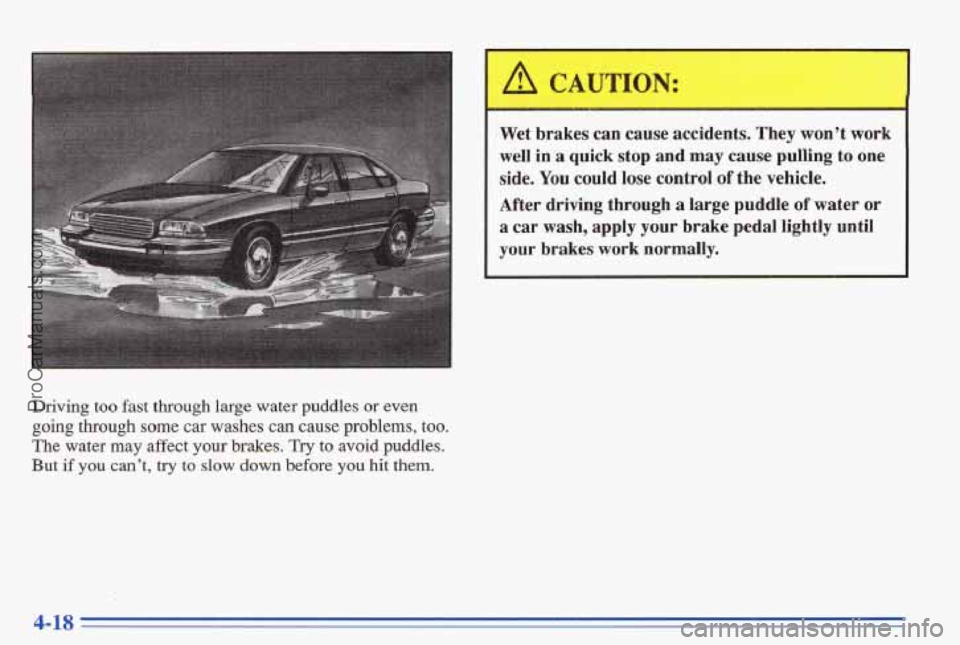
Driving too fast through large water puddles or even
going through some car washes can cause problems, too.
The water may affect your brakes, Try to avoid puddles.
But
if you can’t, try to slow down before you hit them.
.Wet brakes can cause accidents. They won’t work
well in
a quick stop and may cause pulling to ‘one
side.
You could lose control of the vehicle.
After driving through
a large puddle of water or
a car wash, apply your brake pedal lightly until
your brakes work normally.
4-18
ProCarManuals.com
Page 191 of 387
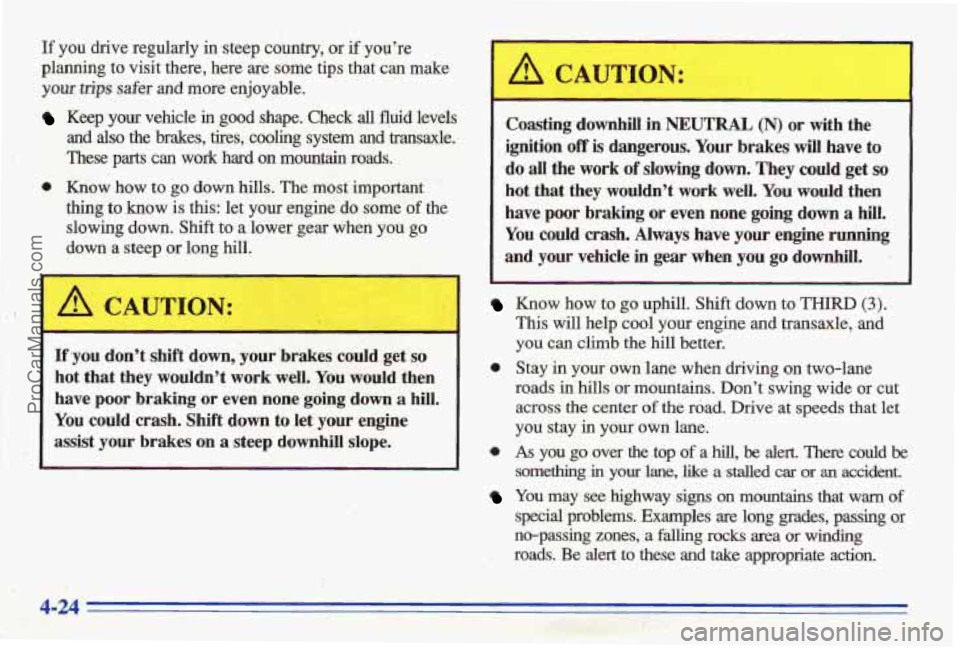
~f you drive regularly in steep country, or if you’re
planning to visit there, here
are some tips that can make
your trips safer and more enjoyable.
Keep you vehicle in good shape. Check all fluid levels
and also the brakes, tires, cooling system and transaxle.
These parts
can work hard on mountain roads.
0 Know how to go down hills. The most important
thing
to know is this: let your engine do some of the
slowing
down. Shift to a lower gear when you go
down a steep or long hill.
If ‘you don’t shift down, your brakes could get so
hot that they wouldn’f work well. You would then
have poor braking
or even none going down a hill.
You could crash. Shift down to let your engine
assist your brakes on
a steep downhill slope. Coasting
downhill in NEUTRAL (N) or with
the
ignition
off is dangerous. Your brakes will have to
do all the work of slowing down. They could get so
hot that they wouldn’t work well. You would then
have
pm braking or even none going down a hill.
1 You could crash. Always have your engine running
~ and your vehicle in gear when you go downhill.
Know how to go uphill. Shift down to THIRD (3).
This will help cool your engine and transaxle, and
you can climb the
hill better.
roads in
hills or mountains. Don’t swing wide or cut
across
the center of the road. Drive at speeds that let
you stay in your own lane.
0 Stay in your own he when driving on two-lane
0 As you go over the top of a hill, be dert. There could be
something in your lane, like a stalled car or an accident.
You may see highway signs on mountains that warn of
specid ‘problems. Examples are long grades, passing or
: I’ no-passing zones, a falling rwkx area or winding
,:\. .. roads. Be alert to these and take appropriate action.
ProCarManuals.com
Page 194 of 387
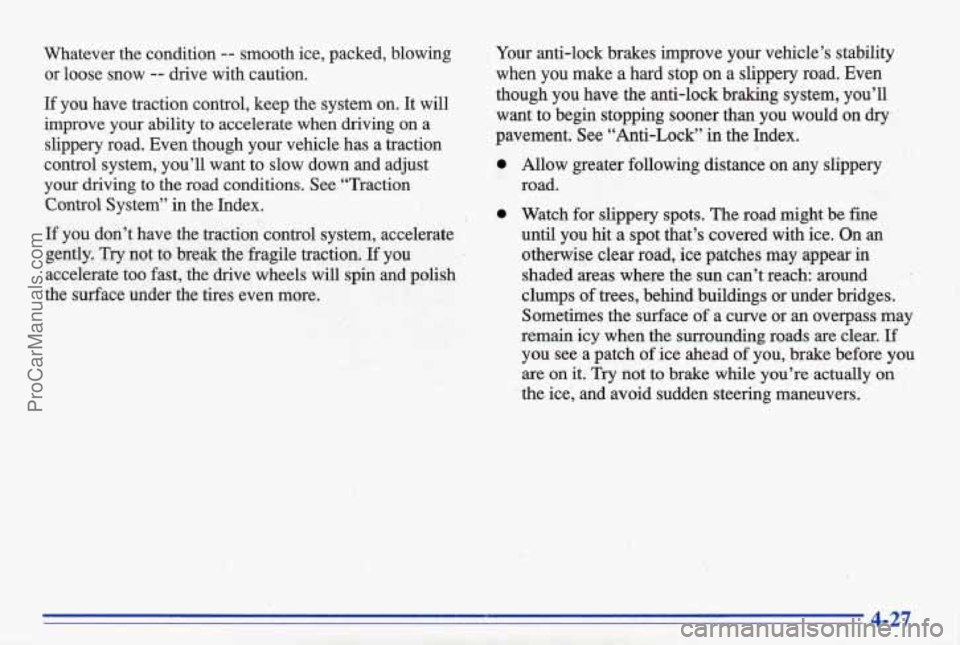
Whatever the condition -- smooth ice, packed, blowing
or loose snow
-- drive with caution.
If you have traction control, keep the system on. It will
ipprove your ability to accelerate when driving
on a
slippery road. Even though your vehicle. has a traction
control system, you’ll want to slow down and adjust
your driving to the road conditions. See “Traction
Control System” in the Index.
If you don’t have the traction control system, accelerate
gently. Try not to break the fragile traction.
If you
accelerate too fast, the drive wheels will spin and polish
the surface under the tires even more. Your
anti-lock brakes improve your vehicle’s stability
when you make
a hard stop on a slippery road. Even
though you have the anti-lock braking system, you’ll want to begin stopping sooner than
you would on dry
pavement. See “Anti-Lock’’ in the Index.
0
0
Allow greater following distance on any slippery
road.
Watch for slippery spots. The road might be fine
until you hit
a spot that’s covered with ice. On an
otherwise clear road, ice patches may appear in
shaded areas where the
sun can’t reach: around
clumps of trees, behind buildings or under bridges.
Sometimes the surface of a curve or
an overpass may
remain icy when the
surrounding roads are clear. If
you see a patch of ice ahead of you, brake before you
are on it. Try not to brake while you’re actually on
the ice, and avoid sudden steering maneuvers.
. . . . .I. . . 4-27
P ProCarManuals.com
Page 199 of 387
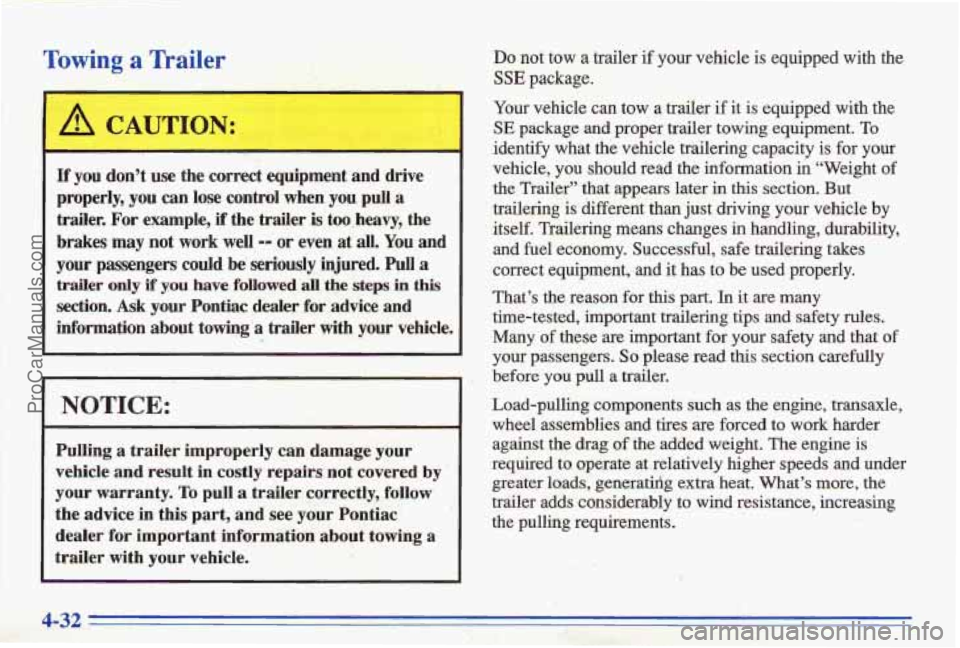
Towing a Trailer
If you don’t use the correct equipment and drive
properly,
you can lose control when you pull a
&der. For example, if the trder is too,heavy, the
brakes
may not work well -- or even at all. You and
your passengers could be’ seriously injured. Pull a
trailer only if you have followed all the steps in this
section. Ask your Pontiac dealer for advice and
information about towing
a trailer with your vehicle.
’ I NOTICE:
~
Pulling a trailer improperly can damage your
vehicle and result in costly repairs not covered by
your warranty.
To pull a trailer correctly, follow
the advice in this part, and see your Pontiac
dealer- for important information about towing a
trailer
with your vehicle.
Do not tow a trailer if your vehicle is equipped with the
SSE package.
Your vehicle can tow a trailer if it is equipped with the
SE package and proper trailer towing equipment. To
identify what’the vehicle ‘trailering capacity is for your
vehicle, you should read the information i.i “Weight of
the Trailer” that appears
later in this section. But
trailehg is different
than just driving your vehicle by
itself. Trailering means changes
in handling;durability,
and fuel economy. Successful, safe trailering takes
correct equipment, and it has
to be used properly.
That’s
the reason for this part. In it are many
time-tested, important trailering tips and safety rules.
Many of these are important for your safety and that of
your passengers. So please read this section carefially
before
you pull a trailer.
Load-pulling_components
such as the engine, transaxle,
wheel assemblies
and tires are forced to work harder
against
the drag of the added weight. The engine is
required to operate at relatively higher speeds and under
greater
loads, generatkig extra heat, What’s more, the
trailer adds considerably to
wind resistance, increasing
the pulling requirements, -
4-32 ‘
.. ProCarManuals.com
Page 202 of 387
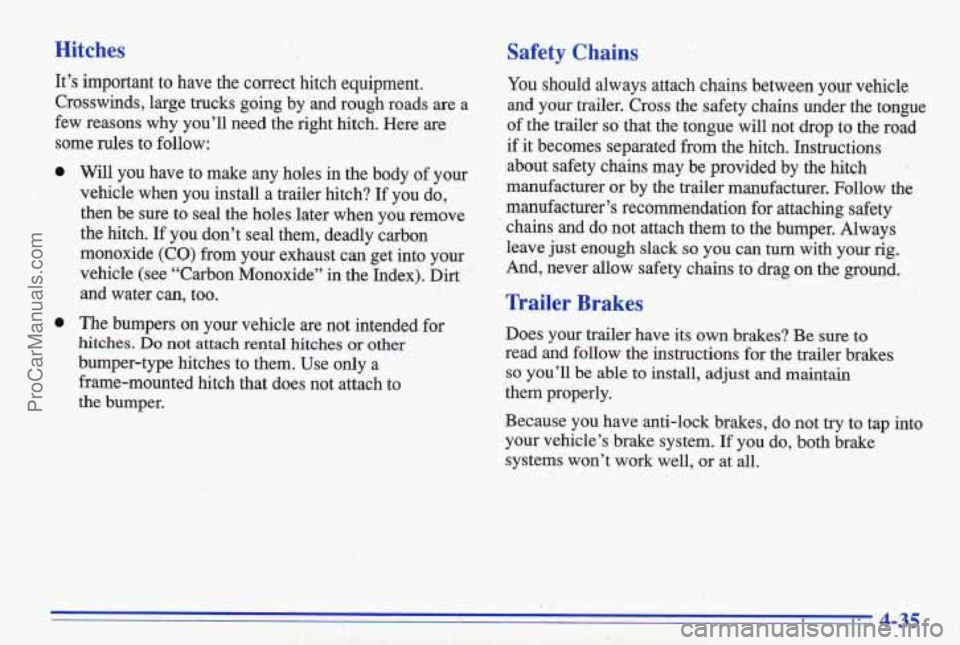
Hitches
It’s important to have the correct hitch equipment.
Crosswinds, large trucks going by and rough roads
are a
few reasons why you’ll need the right hitch. Here are
some rules to follow:
0
a
Will you have to make any holes in the body of your
vehicle when you hstall a trailer hitch?
If you do,
then be sure to seal the holes later when you remove
the hitch.
If you don’t seal them, deadly carbon
monoxide
(CO) from your exhaust can get into your
vehicle (see “Carbon Monoxide” in the Index).
Dirt
and water can, too.
The bumpers
on your vehicle are not intended for
hitches.
Do not attach rental hitches or other
bumper-type hitches to them. Use only a frame-mounted hitch that does not attach to
the bumper.
Safety Chains
You should always attach chains between your vehicle
and your trailer. Cross the safety chains under the tongue
of the trailer
so that the tongue will not drop to the road
if it becomes separated from the hitch. Instructions
about safety chains may be provided by the hitch
.
manufacturer or by the trgler manufacturer. Follow the
manufacturer’s recommendation for attaching safety
chains and do not attach them to the bumper. Always
leave just enough slack
so you can turn with your rig.
And, never allow safety chains to drag on the ground.
Trailer Brakes
(_,.,.. !. ‘I.. ,)-*: 5 , .>:. 1 . -. .,
L,. t .,
Does your trailer have its own brakes? Be sure to
read
and follow the instructions for the trailer brakes
so you’ll be able to install, adjust and maintain
them properly.
Because you have anti-lock brakes, do not
try to tap into
your vehicle’s brake system. If you do, both brake
systems won’t work well,
or at all.
ProCarManuals.com
Page 203 of 387
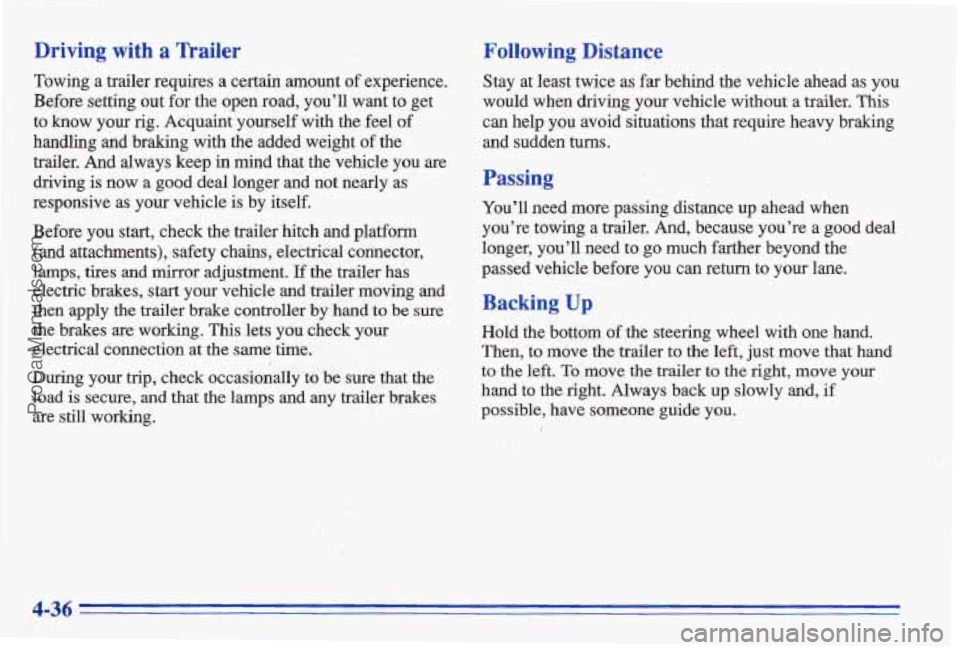
Driving with a nailer
Towing a trailer requires a certain amount of experience.
Before seffing out for the open road, you’ll want to get
to
know your rig, Acquaint yourself with the feel of
handling
and braking with the added weight of the
trailer.
And always keep in mind that the vehicle you are
driving is now a good deal longer and not nearly as
responsive as your vehicle
is by itself.
Before you start, check
the trailer hitch and platform
(and attachments), safety chains, elec.ical connector,
lamps, tires and mirror adjustment. If the trailer has
electric brakes, start your vehicle and trailer moving and
then apply the trailer brake controller by hand to be sure‘
the brakes are working. This lets you check your
electrical connection at the same time.
During your trip, check occasionally to,
be sure that the
load
is secure, and that the lamps and any trailer brakes
are
still working.
Following Distance
Stay at least twice as far behind the vehicle ahead as you
would when driving your vehicle
without a trailer. This
can help you avoid situations that require heavy braking
and sudden
tuns.
Passing
You’ll need more passing distance up ahead when
yuu’re, towing a trailer.
And, because you’re a good deal
longer, you’ll need
to go much farther beyond the
passed vehicle before you can return to your lane.
Backing Up
Hold the bottom of the steering wheel with one hand.
Then,
to move the trailer to the left, just move that hand
to the left. To move the trailer to the right, move your
hand to the right. Always back up slowly and, if
possible, have someone guide
you.
I
I :
4-36
ProCarManuals.com
Page 204 of 387
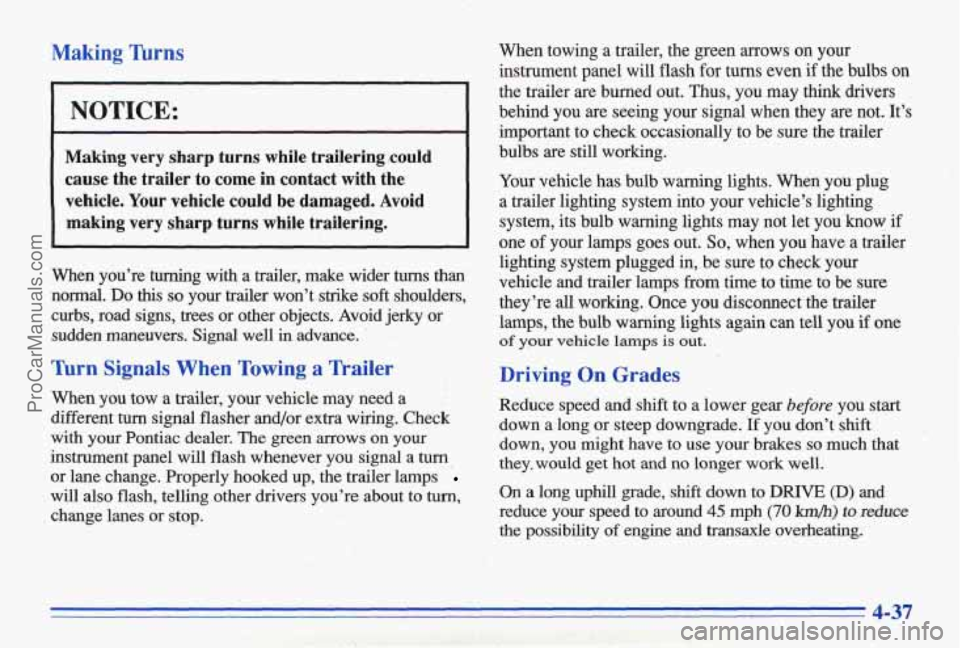
Making Turns
NOTICE:
Making very sharp turns while trailering could
cause the trailer to come in contact with the
vehicle. Your vehicle could be damaged. Avoid
making very sharp turns while trailering.
When you’re turning with a trailer, make wider turns than
normal. Do this so your trailer won’t strike soft shoulders,
curbs, road signs, trees or other objects. Avoid jerky
or
sudden maneuvers. Signal well in advance. ‘
. Turn ,Signals When Towing a Trailer’
When you tow a trailer, your vehicle may need a
different
turn signal flasher and/or extra wiring. Check
with your Pontiac dealer. The green
arrows on your
instrument panel will flash whenever you signal a turn
or lane change. Properly hooked up,’ the trailer lamps
will also flash, telling other drivers you’re about to turn,
change lanes or stop. When towing a trailer, the green arrows
on your
instrument panel will flash for turns
even if the bulbs on
the trailer are burned out.
Thus, you may think drivers
behind you are seeing your signal when they are not. It’s
important to check occasionally to be sure the trailer
bulbs are still working.
Your vehicle has bulb warning lights. When you’plug
a trailer lighting system into your vehicle’s lighting
system, its bulb warning lights may not let you
know if
one of your lamps goes out. So, when you have a trailer
lighting system plugged in, be sure to check your
vehicle and trailer lamps
from time to time to be sure
they’re
all working. Once you disconnect the trailer
lamps, the bulb warning lights again can tell you
if one
of ypur vehicle lamps is out.
Driving On Grades
Reduce speed and shift to a lower gear before you start
down a long or steep downgrade.
If you don’t shift
down, you might have to use your brakes so much that
they. would get hot
and no longer work well.
On a long uphill grade, shift down to Dm (D) and
reduce your speed to around
45 mph (70 km/h) to reduce
the possibility of engine and transaxle overheating.
4-37
ProCarManuals.com